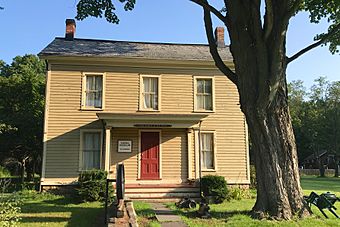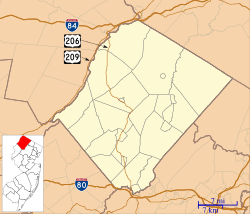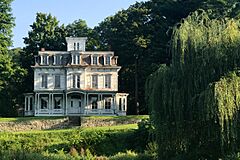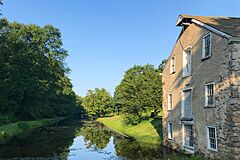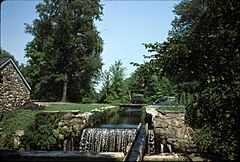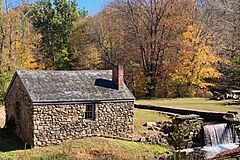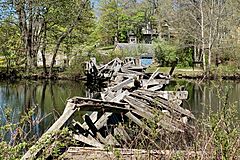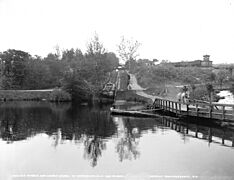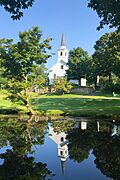Waterloo Village, New Jersey facts for kids
Waterloo Village is a restored 19th-century canal town in Byram Township, Sussex County (west of Stanhope) in northwestern New Jersey, United States. The community was approximately the half-way point in the roughly 102 miles (164 km) trip along the Morris Canal, which ran from Jersey City (across the Hudson River from Manhattan, New York) to Phillipsburg, New Jersey, (across the Delaware River from Easton, Pennsylvania). Waterloo possessed all the accommodations necessary to service the needs of a canal operation, including an inn, a general store, a church, a blacksmith shop (to service the mules on the canal), and a watermill. For canal workers, Waterloo's geographic location would have been conducive to being an overnight stopover point on the two-day trip between Phillipsburg and Jersey City.
It is currently an open-air museum in Allamuchy Mountain State Park. As part of the State Park, it is open to the public from sunrise to sunset. The village was added to the National Register of Historic Places on September 13, 1977.
Contents
Canal and railroad eras
Opened in 1831, the Morris Canal's traffic volume, which was primarily anthracite coal from Pennsylvania, peaked during the late 1860s, shortly after the end of the American Civil War. Up until that time, the local railroads — the Lackawanna Railroad's Sussex Branch and Morris and Essex Railroad — had only supplemented the canal's operation, rather than competing with it. Both railroads ran within a short distance of the village. After the War, the canal's traffic began to quickly shift over to the much faster and more reliable railroad. It was expected that during most winters the canal would be frozen solid, and thus impassable during the time when its chief commodity was in greatest demand.
As a result, the canal underwent a steady decline, and so did Waterloo Village. Although the canal was not officially abandoned until 1924, rarely did more than one boat a year (to fulfill the conditions of the canal's charter) run through the canal after 1900. By the time of the Great Depression, Waterloo Village had been abandoned by its original owners.
Unheralded saviors
The village's location, within a short distance of the Lackawanna Railroad (which had to overcome a steep eastbound grade towards New York near Waterloo, slowing freight trains to a crawl as they labored up the hill to Netcong), made it easy for hobos to jump on and off boxcars.
The hobos, as it turned out, found Waterloo and adopted it as a stopping off point on their cross-country journey towards New York. This new purpose for the village wasn't all that different from its original purpose a century earlier. The hobos protected Waterloo Village by occupying it throughout the 1930s and '40s. The original Waterloo railroad station was moved from the station site during the 1940s and became a private residence on U.S. Route 206 in Mount Olive Township, New Jersey.
Rebirth
Percival 'Percy' Leach established the not-for-profit Waterloo Foundation for the Arts to finance the restoration of the village in 1967. Leach and his partner in the interior design business Lou Gualandi turned it into a living history tourist attraction with working blacksmiths, potters, candle dippers and weavers demonstrated crafts from the colonial historic eras.
The village would eventually become part of New Jersey's Allamuchy Mountain State Park.
Admissions fees being never enough to cover the administrative costs of the attraction, the partners sought out corporate and state grants, but ultimately opened an open-air concert field on the property in 1977 to raise funds.
Notable acts who have performed at Waterloo include Muddy Waters, Johnny Cash, the Beach Boys, Steppenwolf, the Allman Brothers, America, Arlo Guthrie, Phish, Chicago, Roy Orbison, Bob Dylan, Neil Young, Indigo Girls, Edie Brickell, Melissa Etheridge, Joe Cocker, The Moody Blues, Blues Traveler, Ray Charles, "Weird Al" Yankovic, Blue Öyster Cult and three Lollapalooza tours. In addition to pop and rock concerts, Waterloo has also hosted craft shows, ethnic festivals, conventions, Metropolitan Opera, jazz, classical music and the Geraldine R. Dodge Poetry Festival.
Reopening
Since the closing, several organizations have continued to restore aspects of the village. Friends of Waterloo and the Canal Society focused on Canal Town while a non profit called Winakung at Waterloo Inc. focused on the sustainability of the Lenape Indian Village.
Through a concession agreement with the NJDEP Division of Parks and Forestry in 2014, group tours and programs became available at the village by reservation. Winakung at Waterloo Inc. educational programs meet core curriculum standards and are ideal for school trips, scout groups, and summer camp field trips. Winakung at Waterloo Inc. also offers year-round outreach programs for schools, libraries, historical societies, Clean Communities, and more.
In the spring of 2014, a 10-year lease (with the option of 10 more) was awarded to Jeffrey Miller Catering (JAM Catering) out of Philadelphia, making them the exclusive caterer for Waterloo Village. JAM has renovated the Meeting House and Pavilion.
Beginning May 2014, the SMS Italian Festival, an annual Non-Profit event supporting the children of St Michael School, began at the village.
In May 2017, the stage was demolished to prepare for future festivals and make way for a new stage to be built on the grounds.
United Methodist Church
The cornerstone for the Waterloo Village United Methodist Church was set on August 9, 1859, and the church was dedicated on February 9, 1860. General John Smith was the first to be buried in the churchyard cemetery.
Gallery
See also


